‘Mack’ of Mack Amps on EL84s and Tone
Part 1
I’m not an amp builder, but to me EL84 power tubes seem like the little brother to EL34s. As Vox is to Marshall, if you will. Similar tone, but lower-powered.
And while I love EL34 amps – their sheer mind-bending power – I keep running across awesome-sounding EL84 amps. They have the requisite nuts, and seem to be able to cross from edgy blues to rock a little more easily than EL34 amps.
Naturally I try to feed curiosity with knowledge, which is why I called Don Mackrill, owner of Mack Amps. Why him? Because he doesn’t build any EL34 amps. Just EL84 (and 6V6) amps. So obviously he digs the tubes too, and no doubt knows a whole lot more about them than most. Here’s some of what he said on the phone and via email.
WoodyTone: Why did you decide to base your highest-powered amp – the Heatseeker 36 – on EL84 tubes instead of more-popular power tubes like EL34s or 6L6s?
Don: I’ll answer this question from two perspectives: that of a GAS-afflicted tonehead, and an amp builder. I’m guilty of being both.
First, the tonehead. I describe the natural sound of EL84 tubes as “ear candy.” To me they produce a seductive blend of three-dimensional chime, cluck and crystal-clean tones. And when driven hard, addictive crunch and upper-midrange aggressiveness.
Also, depending on the amp, they can produce a prodigious amount of bass. This wide frequency range capability is one reason why EL84s are often found in low-power, high-end stereo amps.
The key factor for getting the most enjoyment out of EL84s is to overdrive them. If an amp uses 84s but relies on preamp distortion for its overdriven tone, you’ll hear ‘fizzy’ 12AX7 distortion being made louder by the 84s. What I love is hearing the 84s themselves being sent into overdrive territory – that’s the juicy power-tube distortion tone Billy Gibbons and many other pros use.
Play a Strat set on the bridge and middle pickups through a good EL84 amp and you’ll be amazed at the harmonic-laden cleans. Or crank it up and hear your Strat’s natural tone being distorted with its distinctive characteristics.
Just as nirvana-like is running a Les Paul through an EL84 amp set up just at the point where the 84s are starting to distort. That’s a recipe for classic blues tone. You can morph between clean and overdrive simply by altering your picking attack. Lots of fun.
Since they produce less power per tube than EL34s and 6L6s, EL84 amps are generally less expensive and not as loud as amps based on their big brothers. As a tonehead that’s great news because I won’t have to spend as much cash on the amp and I’ll still get beautiful cleans and that ‘crush’ of overdriven tone synonymous with Marshall and Vox.
To me, that means an EL84 amp is more versatile than a 34/L6 amp. Unless you’re after massively loud clean tones and need 50 or 100 watts of power to get them, more power than say 30-40 watts is, in my opinion, overkill.
That’s a topic worthy of its own discussion, but just let me say this: Nowadays, any venue big enough to require 100 watts to fill the room will almost certainly have the ability to mic your amp. In that situation a Champ would work just fine!
So from a player’s perspective, the flexibility and the beautiful clean and overdriven tones are why I designed the Heatseeker model line [using EL84s]. And the Heatseeker HS-36 is our most powerful amp because, if you play classic rock and blues, I don’t think more power is required.
I love the way these tubes sound and, since I design stuff that I like, there will always be EL84 amps in the Mack product line.
Now the amp-builder. When designing an amp there are a few basic decisions to be made. Here’s how I arrived at using EL84s for the Heatseeker line.
First, I decided on the general tonality I was after. Meaning, when we encounter a new product of any kind we immediately reference it to relevant icons that we know as a way to help us understand the new product. For a guitar amp, that usually means comparisons with Marshall and Fender, and sometimes Vox and a few others.
That doesn’t necessarily mean a new product should blindly copy the icon, but rather that the icons can be used for reference – unless you’re after something completely new.
In the case of the Heatseeker, the first line on the blank sheet of paper described tone that was a combination of Marshall and Vox. The aggressive upper-mids that characterize Marshall tone and the thick harmonic-laden, Vox-like overdrive and cleans. That was the tone goal.
Second, I had to be answer the age-old question, How much power is enough? I clearly feel that 50+ watt amps aren’t needed so….
Third, I had to determine the balance between features and price. Since Mack’s mission is to make boutique tone accessible to as many guitarists as possible, keeping the price down is critical. Note that a decision about wattage is closely related to price: All other things being equal, more power results in a higher price.
Here’s how this all came together for the Heatseekers. As you’ll see, the decisions are tightly interrelated.
Tone – What tubes would produce the desired ‘Marshall meets Vox’ tonality I was after? EL34s could do it with the right voicing. 6L6s could too, but it would require more circuit tweaking because that tube’s characteristic tone is further from the design goal. And EL84s fit the bill too – Vox used them in their iconic AC line of amps, and the 84’s natural upper-mid emphasis means they can produce Marshall aggressiveness in the right circuit. But what about power and cost?
Power – Dual-EL34 amps are most often designed for 50 watts as are dual 6L6 amps, although some can be had that put out 40 watts. (Incidentally, beware of these [lower-watt, 2-EL34 or -6L6 amps because in my experience ‘big name’ amps of this sort tend to be ‘cold’-sounding – a result of running the amp at lower-than-normal voltages and/or biasing the tubes for maximum life instead of best tone). Quad 34s and L6s are generally rated between 80 and 100 watts.
Dual 84s put out 15-18 watts while quads typically max out at 36. Those are maximum ratings for EL84s, which means they are run at the max safe voltage and biased for slightly under maximum power dissipation. At those power levels they are running at their optimal ‘tone spot’ and sound their best.
I’ve said my opinion of how much power is enough, so four EL84s produce what I believe to be the most power classic rock and blues guitarists will ever need. And at 18 watts, dual-EL84 amps are a fun combination of tone and volume that can still easily be used for stage work.
So the scales were starting to tip toward EL84s. Finally, there was price. How could I stay true to our credo of “Virtuoso Tone without the Prima Donna Price” and still get the specific tonality and power I was after?
As tube output power increases so does the voltage and current required to run them, as does the price of the tube. EL34s and 6L6s require bigger and more-expensive power and output transformers. Plus they cost more than EL84s.
So more scale-tipping toward EL84s.
It’s pretty clear by now that EL84s are an ideal marriage of tone, power and lower-cost. These tubes sound absolutely beautiful in the right circuit. They produce what I believe to be the perfect amount of power. And the resulting amp is relatively inexpensive compared to a dual- or quad-34/L6 amp.
From both a tonehead’s and amp-builder’s perspective, basing the Heatseeker line of amps on EL84s was a pretty easy decision. Four EL84s putting out 36 watts of pure tube tone is a wonderful thing!
– End of Part 1 (of 2) –

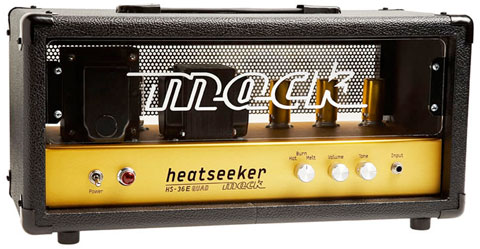
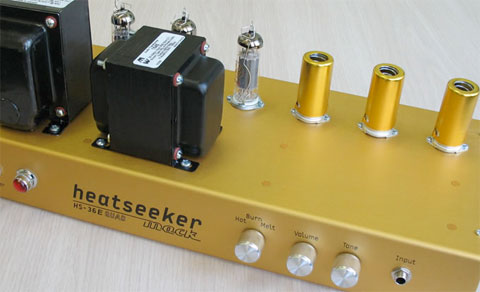




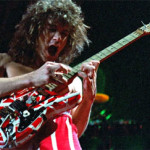
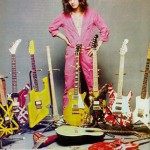
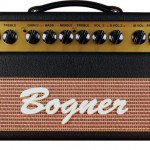
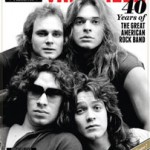
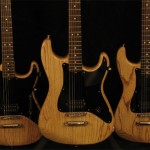
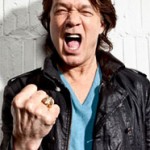
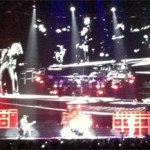
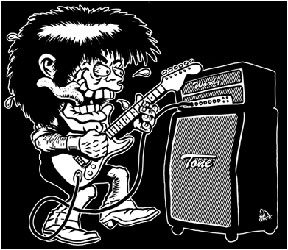

Comments (1)
Trackback URL | Comments RSS Feed
Sites That Link to this Post